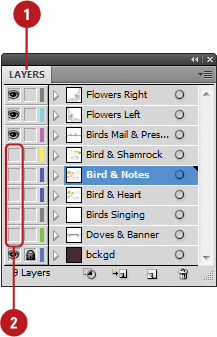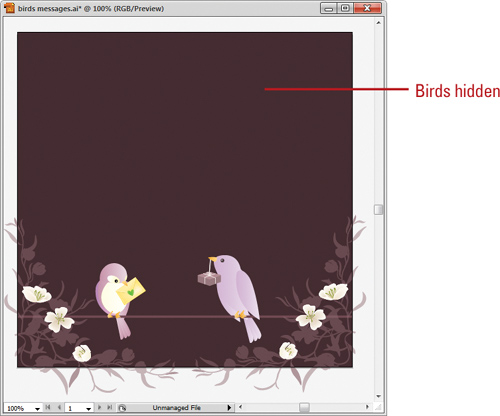Showing and Hiding Layers and Objects
When
you have a lot of objects in the document window, it can be hard to
work with them. In the Layers panel, you hide layers and objects to
reduce the clutter and make it easier to work with the layers and
objects that you want. When you click the visibility (first) column in
the Layers, an eye icon appears indicating the layer is visible. To hide
a layer, you simply click the eye icon to remove it. When you hide a
top-level layer, all the objects within it are also hidden. The eye
icons appear dimmed. You need to make the top-level layer visible to
show all the objects within it. Hidden objects don’t print and don’t
appear in the document window in either Preview or Outline views. When
you save, close, and reopen your document, any hidden objects remain
hidden until you show them.
Show and Hide Objects and Layers in the Layers Panel
 Select the Layers panel.
Select the Layers panel.
 Use any of the following:
Use any of the following:
- Show/Hide Individual. Click the visibility (first) column for each layer that you want to show or hide.
- Show/Hide Multiple. Click and drag the visibility (first) column.
- Show/Hide Top-Level. Click the visibility (first) column for the top-level layer.
All the layers in the top-level are shown/hidden.
- Show/Hide Except One.
Alt+click (Win) or Option+click (Mac) the visibility (first) column for
a top-level layer to show/hide all the other top-level layers except
the one you clicked.


Merging Layers and Groups
If
you have objects on multiple layers and want to consolidate them onto
one layer, you can merge them together. You can merge two or more
groups, or a combination of groups and sublayers (if they are both in
the same top-level layer). However, you can’t merge an object with
another object. If a layer is locked or hidden, you can still use them
in a merge. Before you use the Merge Selected command, it’s a good idea
to make a copy of your document as a backup to preserve a copy of the
separate layers.
Merge Layers and Groups in the Layers Panel
 Select the Layers panel.
Select the Layers panel.
 Select two or more layers, sublayers, or groups that you want to merge.
Select two or more layers, sublayers, or groups that you want to merge.
- Hold down the Ctrl (Win) or
 (Mac) key, and then click to select multiple items.
(Mac) key, and then click to select multiple items.
 Click the last layer into which you want to merge the selected layers.
Click the last layer into which you want to merge the selected layers.
 Click the Options menu, and then click Merge Selected.
Click the Options menu, and then click Merge Selected.

